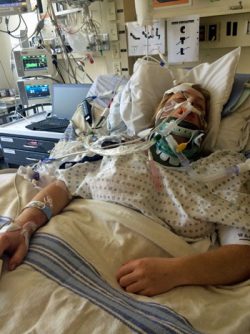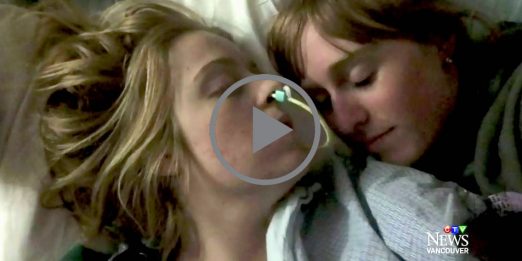World-class care saves a world-class skier
When Jamie Crane-Mauzy stood at the start line of the slopestyle event at the World Ski and Snowboard Festival in Whistler on April 11, 2015, she had no idea it would be the race of her life.
“The last thing I remember was falling asleep the night before. I don’t recall the event at all,” says Jamie.
Just 15 seconds into the competition while attempting a double back flip on the first jump, she crashed. Jamie suffered a severe traumatic brain injury that resulted in microbleeds throughout her brain and brain stem. She was flown to VGH.
Fortunately, the ICU and Neurosurgery teams had been preparing for just this kind of case, and Jamie became B.C’s first patient to undergo a treatment known as autoregulation monitoring.
New treatment at the forefront of medicine

Jamie’s brain needed more oxygen until a catheter, as pictured here, was inserted into her brain to measure its precise blood pressure and oxygen levels.
Pioneered at Cambridge University, only a handful of medical centres around the world use autoregulation monitoring, a technique to determine the precise oxygen and blood pressure levels of a patient’s brain. Critical care physicians Drs. Myp Sekhon and Donald Griesdale studied the treatment in Britain and were instrumental in bringing it to VGH.
“We were gravely worried that Jamie’s brain wasn’t receiving adequate life-sustaining oxygen levels,” says Dr. Sekhon. “We inserted a catheter into her brain, which was attached to a monitor set, and then manipulated her blood pressure with powerful medications to make her heart pump harder. This allowed Jamie’s blood pressure to increase dramatically, and her brain oxygen levels normalized over the ensuing hours.”
Jamie remained in a coma for eight days. Today, she’s skiing again, with no symptoms of the injury that nearly claimed her life.
“I had to learn everything again,” says Jamie, “but I get to live tomorrow because I was treated at VGH.”
Since Jamie’s accident, 36 additional patients have been treated with autoregulation monitoring at VGH. “Sixty per cent of these patients have had favourable outcomes, compared to 37 percent with traditional treatment,” says Dr. Griesdale. “This technique is giving severe brain trauma patients a better shot at recovering to the point where they are able to live independently.”
“Jamie’s case embodies what we can achieve when care teams collaborate,” says Dr. Brian Toyota, Head of Neurosurgery, and the surgeon who inserted the catheter in Jamie’s brain. “Our success is predicated on teamwork, and our metrics for success don’t include gold, silver or bronze — they’re the success of one person leaving VGH better than when they entered.”
Watch the TV coverage
On Tuesday, July 19, Jamie thanked her VGH care team at a media conference. Watch highlights of the event courtesy of CTV News:



Dan Beauvais
This is a wonderful story for Jamie and the staff at VGH. As a social worker that has worked in the ED and ICU I’ve seen first-hand the amazing work that VGH physicians and nurses do. Social Work does not normally get access to the challenging and difficult medical situations seen in an Emergency Department. We are normally found in counselling offices or visiting families at their homes. However, I have had the privilege of being able to work in the ED and ICU and I am so impressed when I see physicians and nurses save lives. Thank you all for your excellent work, and giving me the privilege of being part of these amazing teams. Dan Beauvais